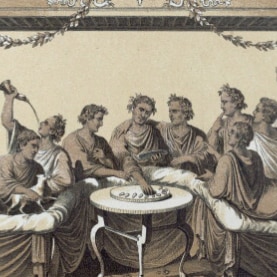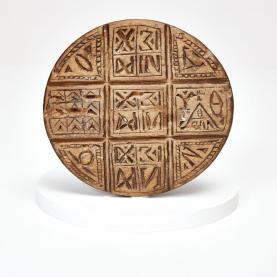Bread and Christianity
The earliest agricultural activities began in the Middle East where bread became a staple food, essential for life. Bread was held in high esteem by several ancient civilisations. In Christianity, it became one of the most important symbols. It was a divine gift, a symbol of generosity and sharing. Everyday gestures and words have evoked the sacred nature of bread.
Nourishing bread
Bread has been the staple food, the representation of life in all cereal-producing countries, particularly in the Middle East, the cradle of agriculture. In Ancient Egypt, Osiris was worshipped as the god of vegetation and revival. He taught the people how to grow wheat and to make flour and bread. The Greeks held bread in high esteem; alongside wine and oil, it was a ‘product of civilisation’. In the Bible, Adam and Eve were chased out of paradise. God condemned Adam to work and earn his bread “by the sweat of his brow” (Genesis 3, 18-19). People moved from gathering food to agriculture. This involved work, expertise and technique and bread was the perfect outcome of this effort.
Characters from the Bible, like the inhabitants of the Middle East and Mediterranean countries, ate bread, prepared in many different ways. Made from wheat, barley, spelt or millet, bread could be seasoned with oil or herbs. Beside the simple round and flat bread, there were galettes and cakes with grapes or honey. Unleavened bread, matzah, is called the ‘bread of haste’, which the Hebrews took with them when fleeing their oppression as slaves in Egypt. Nomads ate unleavened bread as it was prepared quickly. In contrast, leavened bread, hametz, was eaten by sedentary people and it thus represented continuity and patience. Essential for life, bread was the quintessential food. and would frequently refer to food in its entirety.
A symbolic value
In Christianity, bread is one of the most powerful symbols. It is found in the Lord’s Prayer: “Give us this day our daily bread.” This Christian prayer is a request for both actual and spiritual food. Bread is also a gift from God: when Moses fed his people in the desert with food which fell from heaven, and during the last supper, when bread became the body of Christ. When Jesus multiplied the bread to feed the crowd, bread became a sign of sharing. It also symbolised the Word of God which nourished the crowds.
Bread in everyday life
Meaningful gestures have shown the sacred nature of bread. Until not that long ago, the sign of a cross was made on bread before cutting into it. People gave thanks to God before eating. Unlike other food, bread was not thrown away. In the Middle Ages, food was placed on a board or a slice of bread was shared between two. Today, in Central Europe, bread and salt are given as a sign of welcome.
Ezechiel’s recipe
Ezechiel, one of the prophets of the Old Testament who lived around the 6th century BCE, wrote instructions on how to prepare bread. His ingredients are nourishing to say the least: “Take wheat and barley, beans and lentils, millet and spelt. Put them in a storage jar and use them to make bread for yourself.” (Ezechiel, 4-9).
Feinberg Vamosh, Miriam, 2011 (3e édition). Les nourritures aux temps de la Bible. France : Bibli’O
André, Jeremy, 2015. Le christianisme : rites et fêtes. Les symboles chrétiens. Le Point Références, Le christianisme : rites et fêtes. Janvier-février 2015. pp.85-90
Godefroy, Aurélie, 2006. Rites et fêtes du catholicisme. France : Plon
Toussaint-Samat, Maguelonne, 1997. Histoire naturelle et morale de la nourriture. France : In Extenso, Larousse
Courtois, Martine, 1999. Aliments fermentés dans la Bible. In Ferments en folie, 1999. Vevey : Alimentarium. pp. 15 - 17
La Sainte Bible, dite Bible de Jérusalem, 1955, Paris : Le club français du livre.









